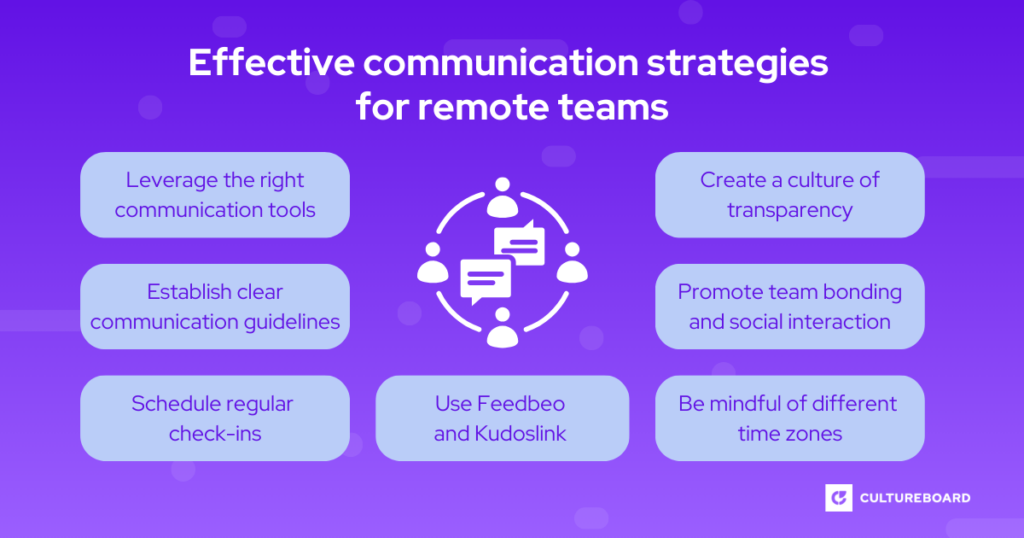Nowadays, remote work has become the norm for many teams across the globe.
While this setup offers flexibility and freedom, it also introduces challenges, particularly when it comes to communication.
Effective communication is the backbone of any successful remote team, ensuring that everyone stays aligned, motivated, and productive.
In this article, we’ll explore practical strategies for fostering clear, efficient, and engaging communication within remote teams.
1. Leverage the right communication tools
Choosing the right tools is the foundation of effective communication in remote teams. Different tasks require different types of communication, and having the appropriate tools ensures that everyone can collaborate seamlessly.
Instant messaging: Tools like Slack, and Microsoft Teams allow team members to have real-time conversations, ask quick questions, and share updates without the formality of email.
Video conferencing: For more personal and detailed discussions, video conferencing tools like Zoom, Google Meet, or Microsoft Teams are essential. Regular video meetings help maintain a human connection, reduce misunderstandings, and allow for more nuanced communication thanks to facial expressions and body language.
Project Management Software: Tools like Asana, Trello, or Monday.com help keep everyone on the same page by organizing tasks, deadlines, and responsibilities. These platforms ensure transparency and provide a centralized place for all project-related communication. This way everyone is aligned on what they have to do and what are the timings for each task.
2. Establish clear communication guidelines
Remote teams can really benefit from having clear communication guidelines that outline how and when to communicate. This helps to avoid confusion, ensure consistency, and respect everyone’s time.
Define your communication channels: Specify which tools should be used for different types of communication. For example, use instant messaging for quick questions, email for formal communication, and video calls for in-depth discussions.
Set expectations for response times: To avoid the frustration of waiting for replies, establish clear expectations around response times. For instance, team members should aim to respond to messages within a few hours during working hours. This one is especially important when working async or with people from different time zones.
Encourage over-communication: In a remote environment, it’s better to over-communicate than to leave things unsaid. Encourage team members to be clear, explicit, and detailed in their communications to avoid misunderstandings.
3. Schedule regular check-ins
Regular check-ins are vital for maintaining a strong team dynamic and ensuring that everyone feels connected and supported.
Daily stand-ups: These are short, focused meetings where team members briefly share what they’re working on, any challenges they’re facing, and what they plan to do next. Stand-ups help keep everyone aligned and aware of each other’s progress.
Weekly team meetings: A longer weekly meeting can be used to discuss larger issues, review progress on key projects, and plan for the week ahead. This is also a good time to address any team-wide concerns and celebrate achievements.
One-on-one meetings: Regular one-on-ones between managers and team members provide a private space for feedback, personal updates, and addressing individual challenges. These meetings are crucial for maintaining strong relationships and ensuring everyone feels supported.
4. Create a culture of transparency
Transparency builds trust and helps to create a more cohesive team, even when working remotely.
Share updates regularly: Keep everyone in the loop by sharing updates on company news, project progress, and any changes that might affect the team. This could be done through a weekly newsletter, a shared document, or a dedicated channel in your communication platform.
Encourage open dialogue: Create an environment where team members feel comfortable sharing their thoughts, ideas, and concerns. This can be encouraged through anonymous surveys, open-door policies, and promoting a culture of feedback.
Feedbeo can be a great help in this matter since it allows users to submit questions anonymously so you go over them on your next Q&A session or All-hands meeting.
Document everything: To ensure that everyone has access to the same information, document decisions, processes, and key discussions. Use shared drives or project management tools to keep all relevant documents easily accessible. This makes it a lot easier to onboard new employees, change responsibilities within the team, and more.

5. Promote team bonding and social interaction
Remote work can sometimes feel isolating, so it’s important to foster a sense of community and connection among team members.
Virtual coffee breaks: Schedule informal virtual hangouts where team members can chat about non-work-related topics. These sessions help to build relationships and make the team feel more connected.
Team building activities: Engage in virtual team-building exercises, such as online games, quizzes, or even remote workshops. These activities help to break the monotony and strengthen team cohesion.
Celebrate milestones and achievements: Recognize and celebrate team successes, birthdays, and other personal milestones. A simple shoutout in a team meeting or a dedicated channel can go a long way in boosting morale and making everyone feel valued. Creating a Kudoslink card is another great option to celebrate your colleagues.
6. Be mindful of different time zones
For global teams, time zones can pose a significant challenge to effective communication. Being mindful of this can prevent unnecessary stress and improve collaboration.
Schedule meetings at convenient times: Try to find meeting times that are reasonable for everyone. If that’s not possible, rotate the meeting times to ensure that no one consistently has to attend meetings outside of their regular working hours.
Use asynchronous communication methods: Allow for communication that doesn’t require everyone to be online at the same time. This could include recorded video updates, shared documents, or project management tools where team members can contribute at their own pace.
Respect work hours: Encourage team members to respect each other’s work hours and avoid sending messages or expecting responses during off-hours. This helps to maintain a healthy work-life balance and reduces anxiety and burnout.
7. Use Feedbeo and Kudoslink for enhanced engagement
In a remote setting, keeping everyone engaged and ensuring that every voice is heard can be challenging. As we mentioned above, this is where tools like Feedbeo and Kudoslink come in handy.
Interactive Q&A sessions with Feedbeo: Feedbeo allows you to run live Q&A sessions where team members can submit questions, vote on the most important ones, and get their concerns addressed in real-time. This not only makes meetings more interactive but also ensures that the most relevant issues are discussed.
Recognition with Kudoslink: Kudoslink is an excellent tool for recognizing and celebrating the achievements of team members. Whether it’s a job well done or a personal milestone, Kudoslink helps create a positive work environment by making sure everyone feels appreciated. This can be particularly powerful in remote teams where recognition might otherwise be overlooked.
Conclusion
Effective communication is the key to a successful remote team. By leveraging these strategies, you can ensure that your remote team remains productive, engaged, and connected.
Incorporating innovative tools like Feedbeo and Kudoslink enhances, even more, your ability to maintain high levels of engagement and recognition, which is crucial for remote team success.
With these actions, your team will not only exist but thrive in the remote work environment.
